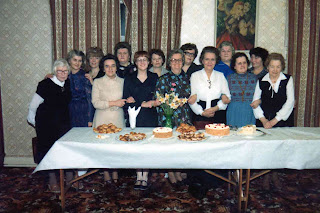There is nothing nicer than having a batch fresh out of the oven. Folk law has it the a single girl will find a husband faster, if she eats the first Pirags that comes out of the oven.
Once the piragi are cooked they will stay fresh in an air tight container for 3 days but they can also be frozen and reheated either in the microwave or oven.
Piragi are often shared with friends at Jani and other Latvian gatherings.
My Recipe
Dough
2 envelopes dry yeast
1 teaspoon sugar
1 cup (about 1/2 pint) scalded milk,
cooled enough that it won't kill the yeast or is too hot for your hands.
1/2 cup (about 4 oz) melted butter
up to 6 tbs sugar (min 2tsps but it is added to taste)
1 teaspoon salt
1/4 teaspoon ground cardamom seeds (optional)
1 tbs grated lemon peel (optional)
4 cups or 1 lb flour
3 eggs, well beaten
Keep the flour handy you may need to add more as the exact amount is done by feel.
Filling
2 pounds bacon, diced
1 medium onion, minced
Black pepper to taste
Method
Cook the bacon in a fry pan over medium heat for 5 to 10 minutes or until cooked through, not crisp, stirring in the onion when bacon is partially cooked.
Remove from heat. Leave to cool.
Dissolve the yeast and 1 teaspoon sugar in 1/4 cup warm water.
Mix the milk, butter and up to 6 tbs sugar in a bowl.
Gradually add in the yeast mixture, salt, flour, lemon rind and cardamom.
Stir in the eggs.
Knead on a floured surface until smooth and elastic.
The dough should come cleaning off your fingers.
.
Place in a greased bowl, turning to coat.
Let rise, covered, in a warm place until doubled in bulk.
(1 -1 1/2 hrs approximately)
Preheat the oven to 400 degrees.
Cut off some dough, cover the remaining dough back up. Lightly roll into a 2 1/2 inch sausage shape. Mark the sausage roll into equal segments.
Work with one segment (round) at time and shape the segment into a circle.
Place a spoonful of the bacon mixture on each dough circle, fold, seal and fold again, making a quarter-moon shape. Place seam side down onto a baking sheet lined with silicone paper. Brush with a beaten egg white and water glaze.
Bake At 375 for 10 to 15 minutes or until golden brown.(actual timing will depend on size)
Check them every minute once they have been cooking for 10 minutes piragi are very easy to burn and if overcooked become dry and brittle.
Remove from oven. Brush with butter or mist with water.









